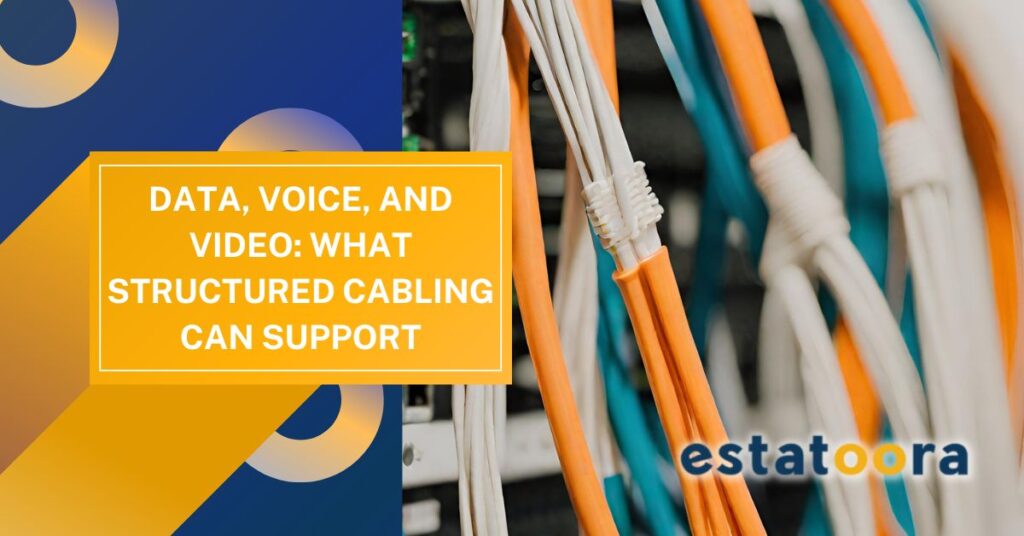
In today’s interconnected world, homes and businesses increasingly rely on a wide range of technologies to function efficiently. A robust and well-organized network infrastructure is essential to support these ever-evolving needs. Structured cabling provides a standardized and future-proof foundation, ensuring reliable connectivity and seamless communication across a variety of systems.
Understanding Structured Cabling: The Backbone of Your Network
Unlike haphazard, point-to-point wiring setups, structured cabling adheres to industry standards and best practices. This systematized approach involves the organized installation of high-quality cables, connectors, patch panels, and other hardware. By following these standards, structured cabling offers several key advantages:
- Reliability: Properly installed components and adherence to standards minimize signal interference and downtime, ensuring your network remains consistently operational.
- Performance: Structured cabling supports high-speed data transmission, crucial for handling the demands of bandwidth-intensive applications without bottlenecks.
- Scalability: Adding devices, expanding your network, or upgrading to newer technologies becomes much simpler with a well-structured cabling system in place.
- Manageability: Organized and labeled cabling simplifies troubleshooting, maintenance, and any necessary changes or additions to your network.
What Can Structured Cabling Support?
Modern structured cabling systems are incredibly versatile, designed to support a multitude of technologies essential for homes and businesses:
1. Data Networking
- Wired Ethernet Connections: Structured cabling forms the backbone of most data networks, providing stable and reliable connections for computers, servers, printers, and an array of network devices.
- Wireless Access Points (WAPs): While WiFi provides wireless connectivity, structured cabling delivers power and data to WAPs throughout your building, ensuring strong signal coverage.
- Point-of-Sale (POS) Systems: Retail and hospitality businesses rely on structured cabling to connect POS terminals, enabling seamless transaction processing.
- IP Security Cameras: Power over Ethernet (PoE) capabilities within structured cabling eliminate the need for separate power sources for surveillance cameras, significantly simplifying installation and ongoing maintenance.
2. Voice Communication
- Traditional Telephone Systems (VoIP): Voice over Internet Protocol (VoIP) phone systems leverage structured cabling to transmit voice data alongside data traffic, offering cost savings and advanced features compared to analog phone lines.
- Intercom Systems: Structured cabling can support both analog and modern IP-based intercom systems, enabling communication within a building or even across multiple locations if desired.
3. Video Distribution
- Digital Signage: Structured cabling can be used to distribute video signals to display screens throughout your facility, whether for informational purposes, showcasing marketing content, or live feeds.
- Audio/Video Systems: Structured cabling can support HDMI and other AV connections for conference rooms, home theaters, and presentation spaces, ensuring high-quality audio and video transmission.
- Television Distribution: Centralized systems can utilize structured cabling to deliver cable or satellite TV signals to multiple rooms within a home or commercial building.
Choosing the Right Structured Cabling Category
The specific type of cable you’ll need depends on the speed and bandwidth requirements of your applications. Here’s a breakdown of common cabling categories:
- Cat5e: An older standard, Cat5e is still adequate for basic network connectivity and VoIP phones in many cases, but is generally being phased out for new installations.
- Cat6: The most common choice currently, Cat6 offers gigabit speeds and excellent performance over typical wiring distances.
- Cat6a: Ideal for high-bandwidth applications, long cable runs, and future-proofing your network for 10-gigabit speeds, Cat6a is gaining popularity in future-focused installations.
- Fiber Optic: Offering the highest bandwidth and longest transmission distances, fiber optic cabling is primarily used in demanding networks, data centers, or for connections between buildings where a high-speed backbone is necessary.
Factors That Impact Your Structured Cabling Needs
Several factors must be carefully considered to design an effective structured cabling system that aligns with your specific needs and requirements:
- Building size and layout: The complexity of your cabling system will depend on the square footage, number of floors, and desired network coverage throughout your space. A larger or more complex layout may necessitate additional cabling, network switches, or wireless access points for complete connectivity.
- Number of devices: Assess both the current number of devices requiring wired connections and the potential for future expansion. Your cabling infrastructure should be designed to accommodate growth without requiring major overhauls.
- Industry-Specific Applications: Specialized industries may have unique cabling requirements, such as for manufacturing equipment with specific connectivity needs or healthcare systems with enhanced security considerations.
- Security and Compliance: Some industries must adhere to specific regulations that might influence your cabling choices and overall network design. Ensure your chosen cabling solution supports the implementation of necessary security measures.
Benefits of Professional Structured Cabling Installation
While attempting a DIY structured cabling installation might seem tempting, professional services offer significant advantages, saving you time and ensuring long-term performance:
- Expertise: Experienced technicians have in-depth knowledge of industry standards, best practices, and optimal cable selection to ensure proper installation that maximizes the lifespan and efficiency of your system.
- Testing and Certification: Reputable installers will thoroughly test your cabling system to guarantee it meets performance expectations, providing documentation and certifications that can be valuable for troubleshooting or future upgrades.
- Future-Proof Design: Experts can create a scalable and adaptable network infrastructure that anticipates your potential growth while keeping an eye toward advancements in technology.
- Time Savings: Professionals work efficiently, getting your network up and running quickly while minimizing disruption to your home or business operations.
- Warranties and Support: Many structured cabling installers offer warranties on their workmanship and the components they use, providing peace of mind and valuable support if issues arise.
Beyond the Basics: Advanced Applications of Structured Cabling
As technology continues to evolve, structured cabling remains adaptable, supporting emerging applications that demonstrate its value and versatility:
- Building Automation Systems (BAS): Integrate lighting, HVAC, access control, security systems, and more using structured cabling for centralized control, improved energy efficiency, and enhanced building management.
- Access Control: Connect card readers, biometric scanners, and electronic locks to structured cabling, enabling secure access management throughout your facility.
- Distributed Antenna Systems (DAS): Enhance cellular coverage within a building by connecting antennas to structured cabling, ensuring strong signals in challenging environments like warehouses, basements, or large multi-story facilities.
- Internet of Things (IoT) Devices: Structured cabling can power and connect a wide range of IoT sensors, smart devices, and industrial equipment across various sectors, supporting automation, data collection, and remote monitoring capabilities.
Ready to experience the benefits of a well-designed structured cabling system? Explore Estatech’s network infrastructure services and discover the difference.



